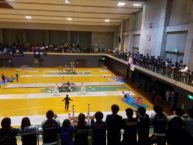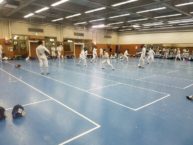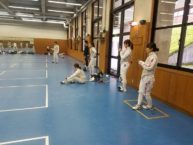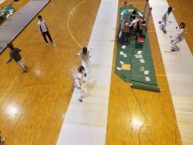For my CIP I attended Doshisha Univerisity Tennis Team where most of the members are either from Doshisha University itself, or Doshisha International High School which lies right next to Doshisha University Tanabe campus. Because I am a member of tennis club back at my home institution, I really want to use my CIP as an opportunity to both maintain my skills and engage with Japanese student in college and get an insight of how they practice. Unfortunately due to the fact that how far Tanabe campus is, I cannot really practice as regularly as all team members. Despite that, however, being able to join the team is definitely one of my greatest experience in Kyoto.
I was very nervous when I contacted the team first. No pervious student had never tried to join Doshisha University’s team, which is one of the best, or maybe the best college tennis team in all Kansai area. As an exchange student who has no experience regularly practicing in a formal team, I actually never thought I would be accepted. Surprising the director replied right away and scheduled the meeting, and I was placed at the International High school team first. After several practices, I was lucky enough to practice with regular members. Unlike tennis meeting back at my home institution, which focus more on using tennis as a tool to develop friendships, while practices with Doshisha University’s team members was much tougher and focus on tennis itself more, and at first I hardly found any chance to communicate with other members. What helped me out most is the courage to overcome the fear of language barrier. As the time went on, I pushed myself to move out of my comfort zone and talked as much as I can, and I soon found out that, outside the court, team members were actually all very talkative and eager to share their understanding about tennis and life at Doshisha even though they looked super serious on the court. In order to really become a member of the team, I shared an enormous amount of information about my interesting experiences in Japan, how I practice back in Boston, and whatever I can think of. In return, they became my best teachers and told me everything about Doshisha, interesting places around the campus and what did they outside tennis courts. Meetings with Doshisha International High school team were more relaxed. Compare to practice in Doshisha University, We did easier and more interesting practices, and I had more times to chat with high school students to know about the common life of Japanese high school students, but not college students. I was also lucky enough to have the opportunity to let them show me around and see the beautiful landscape of countryside around Tanabe campus. I could not believe that we even played Onigokko at a shrine together!
Overall, this has been one of the most memorable parts of my time here at Kyoto. I never expected that my interest in tennis would lead me to so many precious relationships with coaches and team members at Doshisha University and International High School team. Without the CIP I would not have been able to make as many friends and know as much about students’ life in Doshisha as I have here. I definitely think my participation in Doshisha University tennis team was a remarkable choice and I succeed in emerging into the team and leveling up my tennis skills while getting some insight on Doshisha’s students and culture.




